Bedfordshire's Women's Land Army During the First World War
The Women's Land Army (WLA) - the National Organisation
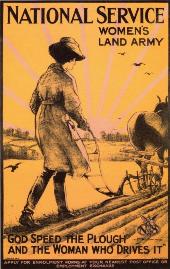 The
first so-called Women's Land Army was recruited by the British government as a
civilian labour force during the years 1917 to 1919 during 'The Great War' with
Germany. It recruited women on a county-wide basis to help farmers by replacing
the thousands of male farm workers who had left work on the land to join the
armed forces.
The
first so-called Women's Land Army was recruited by the British government as a
civilian labour force during the years 1917 to 1919 during 'The Great War' with
Germany. It recruited women on a county-wide basis to help farmers by replacing
the thousands of male farm workers who had left work on the land to join the
armed forces.
(Henry Gawthorn's recruitment poster for the Women's Land Army 1917. Courtesy of
the Imperial War Museum)
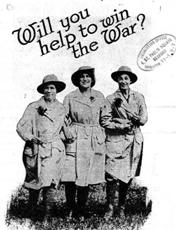 This was the first time that Britain had experienced total war
involving civilians as much as the armed forces and women had been drawn into
work previously considered 'men's work'. Thousands had been recruited into
factories producing munitions and other essential items for the war effort. Now
they were asked to take up physical work on the land.
This was the first time that Britain had experienced total war
involving civilians as much as the armed forces and women had been drawn into
work previously considered 'men's work'. Thousands had been recruited into
factories producing munitions and other essential items for the war effort. Now
they were asked to take up physical work on the land.
(Will you help win the war? Recruiting leaflet, c1917. BLARS
WW1/WA5/1/1)
Traditionally women's work on farms was limited to dairy work, looking after hens and egg production, caring for young animals and occasional seasonal harvesting work. Now the Food Production Department was set up under Rowland Prothero, President of the Board of Agriculture, and women aged 18 and over were invited to volunteer to do paid general work for local farmers. Those accepted were offered six weeks of training in 'light farm work' on selected 'practice farms' and then offered their services with milking, care of animals and work in the fields.
Take-up by farmers was slow because of prejudices against women workers and a conservative attitude to the role of women. It was also difficult to persuade many women to take on low-status work on the land.
However, Bedfordshire Women's War Agricultural Committee set about recruitment and by June 1917 had opened an office at 15A St Paul's Square, Bedford. The county was divided into 14 districts and women district representatives appointed to register all local women prepared to take part. Although there were opportunities to work in forage (food for soldiers' horses) and timber cutting sections, most of the 'land girls' in Bedfordshire volunteered for the Land Army Agriculture Section (LAAS). They signed up for either 6 months or one year at a time.
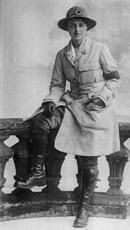 Their
pay in 1917 was 18 shillings (90p) per week and, later, after passing Efficiency
Tests, £1 per week, with special additional rates for hay time and harvest. Pay
improved a little over the next two years. Free uniform work clothing was
provided and included boots, gaiters, clogs, overalls, breeches (a rather
shocking innovation at that time, when women had not previously worn trousers),
hat, jersey and mackintosh.
Their
pay in 1917 was 18 shillings (90p) per week and, later, after passing Efficiency
Tests, £1 per week, with special additional rates for hay time and harvest. Pay
improved a little over the next two years. Free uniform work clothing was
provided and included boots, gaiters, clogs, overalls, breeches (a rather
shocking innovation at that time, when women had not previously worn trousers),
hat, jersey and mackintosh.
(Studio photo of Dorothy Brown who worked as a land girl at The Grange, Gunthorpe, Peterborough. Photo courtesy of Valerie Linder
)
A lapel badge was issued to show that they were doing approved war work and 'good service' stripes awarded after six months of satisfactory work. By October 1917 there were 899 part-time and 496 full-time women workers on Bedfordshire farms and a proportion of these were the new 'land girls' who had taken on the challenge just for the period of the war. They were accommodated either on the farm where they worked, in billets locally with farm workers or in special hostels set up for them around the county, from an empty farmhouse in Cotton End, Bedford, in the north, down to Luton Hoo Home Farm bothy in the south of the county. There was a Timber Department hostel at Clophill. Mobile gangs of 'potato pickers' were based at a hostel at Wren Park, Shefford, from May 1918.
Work was hard for these women and was often the first time they had been away from home. Schemes such as Landworkers' Libraries of donated books were established and Christmas entertainment treats offered by organisations such as the YWCA and the Girls' Friendly Society in Bedford. A monthly magazine The Landswoman was published from 1918 onwards.
Bicycles were provided to enable women workers to travel to and from work between their hostels and their farms. New women's clubs, called Women's Institutes were set up in villages, for the first time, to encourage self-sufficiency and mutual support by women, both locals and those 'land girls' who had moved into an area.
Most 'land girls' were milkers or field workers but a minority did specialised work as carters, early tractor drivers, 'ploughmen', thatchers, shepherds or in horticulture on market gardens.
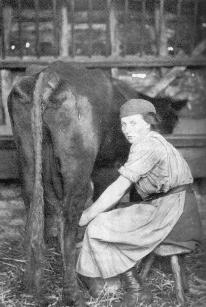
Kathleen Hull milking at Bridge Farm, Great Barford c1914
BLARS Slide 5175
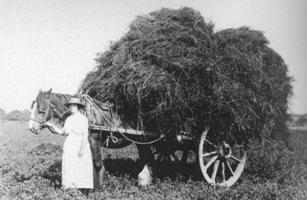
Carrie Partridge with hay cart at Town Farm, Riseley,
c1916-1919
BLARS Z50/96/37
When 'The Great War' ended with the Armistice in November 1918, women continued to work on the land until men eventually returned after demobilisation in 1919. Most of these new women farm workers returned to their homes and previous work when the Women's Land Army was disbanded on 30 November 1919 but a few volunteered to stay on where the farmers were prepared to employ them.
Nationally some 23,000 women had trained up and taken on farm work during the First World War with, at its peak, some 16,000 'land girls' working around the country at any one time. In Bedfordshire, some 550 Land Army members had worked for 90 farmers for various periods of time. On demobilisation 44 were able to stay on as permanent workers on their farms. The majority gave way to those returning male farm workers who had survived their war service.
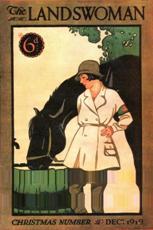 Meriel Talbot, the senior civil servant who had been Director of
the Women's Branch of the Board of Agriculture, wrote in the last issue of The Landswoman with gratitude of the opportunity for service it had given to rural
women and for the door open to women to take their place in the agricultural
life of the country. The transformation in the image of women which the
appearance of 'land girls' in trousers, breeches and puttees had brought about
was, however, short-lived. Twenty years later, other young women were to
encounter these same prejudices at the outbreak of the Second World War.
Meriel Talbot, the senior civil servant who had been Director of
the Women's Branch of the Board of Agriculture, wrote in the last issue of The Landswoman with gratitude of the opportunity for service it had given to rural
women and for the door open to women to take their place in the agricultural
life of the country. The transformation in the image of women which the
appearance of 'land girls' in trousers, breeches and puttees had brought about
was, however, short-lived. Twenty years later, other young women were to
encounter these same prejudices at the outbreak of the Second World War.
(Kathleen Hale's cover for The Landswoman, December 1919.
Courtesy of The Women's Library, London School of Economics)
More detailed article on the Women's Land Army in Bedfordshire during the First World War
Some Bedfordshire First World War Land Girls' names and test locations
Ruth Hendry - Welfare Officer for land girls in Bedfordshire, 1918-1919
A Bedfordshire Land Girl during the First World War
Find out more about the Women's Land army in England and Wales during the First World War
Find out about the Women's Land Army During and After the Second World War
Further reading on the Women's Land Army
Stuart Antrobus Historian/Author
Page last updated: 11th January 2017

